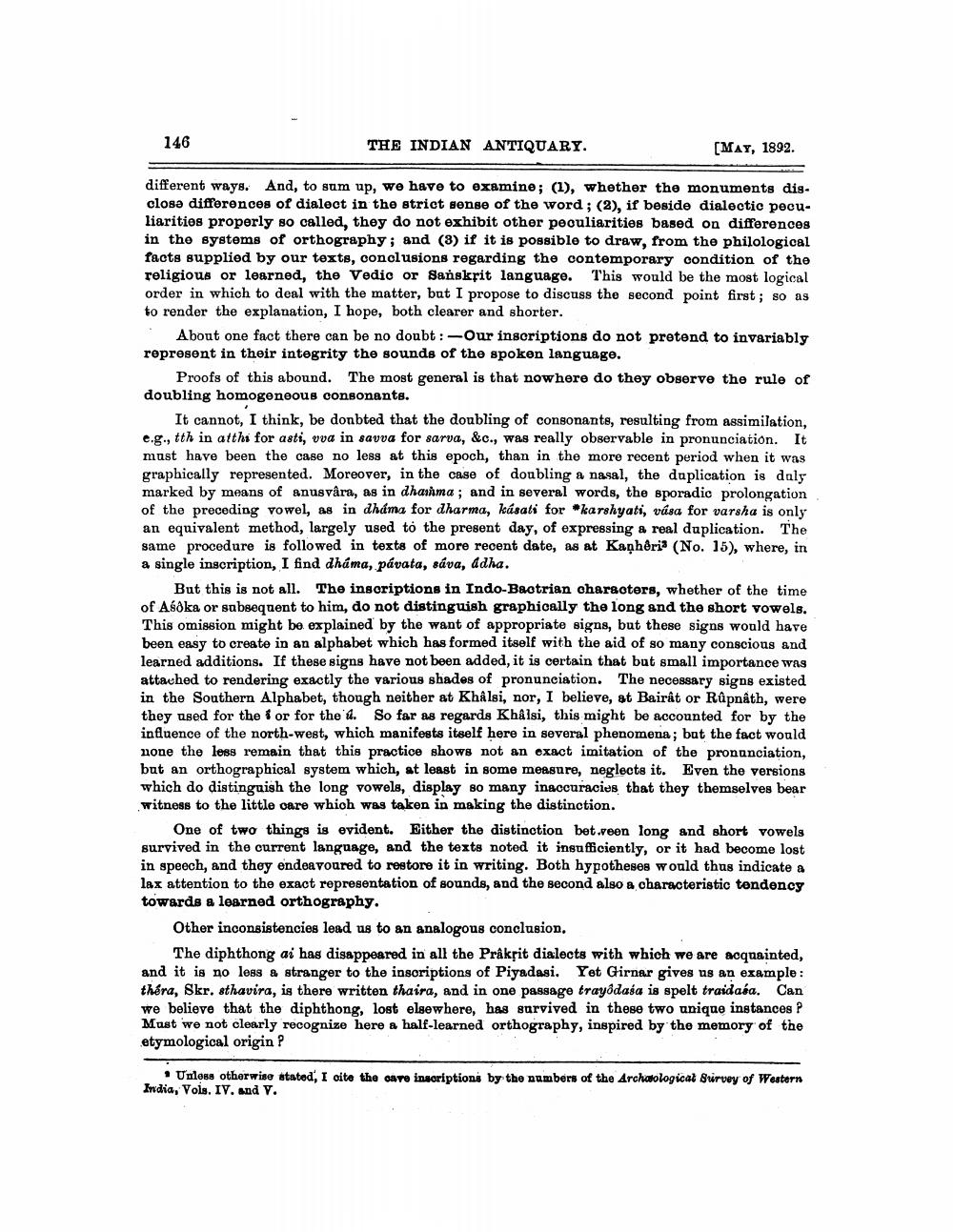________________
146
THE INDIAN ANTIQUARY.
[MAY, 1892.
different ways. And, to sum up, we have to examine; (1), whether the monuments dis. closa differences of dialect in the strict sense of the word ; (2), if beside dialectic peculiarities properly so called, they do not exhibit other peouliarities based on differences in the systems of orthography; and () if it is possible to draw, from the philological facts supplied by our texts, oonclusions regarding the contemporary condition of the religious or learned, the Vedio or Sanskrit language. This would be the most logical order in which to deal with the matter, but I propose to discuss the second point first; so as to render the explanation, I hope, both clearer and shorter.
About one fact there can be no doubt :-Our inscriptions do not pretend to invariably represent in their integrity the sounds of the spoken language.
Proofs of this abound. The most general is that nowhere do they observe the rule of doubling homogeneous consonants.
It cannot, I think, be donbted that the doubling of consonants, resulting from assimilation, e.g., tth in atthi for asti, vva in savva for sarva, &c., was really observable in pronunciation. It must have been the case no less at this epoch, than in the more recent period when it was graphically represented. Moreover, in the case of doubling a nasal, the duplication is duly marked by means of anusvára, as in dhaima; and in several words, the sporadic prolongation of the preceding vowel, as in dháma for dharma, kúsali for *karshyati, vása for varsha is only an equivalent method, largely used to the present day, of expressing a real duplication. The same procedure is followed in texts of more recent date, as at Kanhörid (No. 15), where, in a single inscription, I find dháma, pávata, sáva, ddha.
But this is not all. The inscriptions in Indo-Bactrian characters, whether of the time of Asoka or subsequent to him, do not distinguish graphically the long and the short vowels. This omission might be explained by the want of appropriate signs, but these signs would have been easy to create in an alphabet which has formed itself with the aid of so many conscious and learned additions. If these signs have not been added, it is certain that but small importance was attached to rendering exactly the various shades of pronunciation. The necessary signs existed in the Southern Alphabet, though neither at Khålsi, nor, I believe, at Bairât or Rûpnåth, were they used for the i or for the it. So far as regards Khálsi, this might be accounted for by the influence of the north-west, which manifests itself here in several phenomena; but the fact would none the less remain that this practice shows not an exact imitation of the pronunciation, but an orthographical system which, at least in some measure, neglects it. Even the versions which do distinguish the long vowels, display so many inaccuracies that they themselves bear witness to the little care which was taken in making the distinction.
One of two things is evident. Either the distinction bet.veen long and short vowels survived in the current language, and the texts noted it insufficiently, or it had become lost in speech, and they endeavoured to restore it in writing. Both hypotheses would thus indicate a lax attention to the exact representation of sounds, and the second also a characteristic tendency towards a learned orthography,
Other inconsistencies lead us to an analogous conclusion.
The diphthong ai has disappeared in all the Pråkpit dialects with which we are acquainted, and it is no less & stranger to the inscriptions of Piyadasi. Yet Girnar gives us an example: théra, Skr. sthavira, is there written thaira, and in one passage trayôdasa is spelt traidaća. Can we believe that the diphthong, lost elsewhere, has survived in these two unique instances ? Must we not clearly recognize here a half-learned orthography, inspired by the memory of the etymological origin ?
* Unless otherwise stated, I cite the care inscriptions by the numbers of the Archwological Survey of Western India, Vols. IV. and Y.




